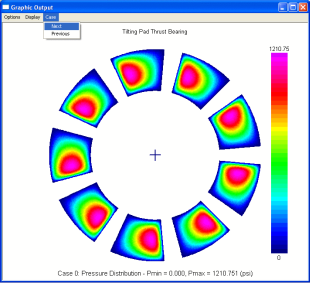Optional Component:
ThrustBrg
This thrust  bearing program has been developed based on the finite element method to accurately predict the performance of various hydrodynamic thrust bearings, such as:
bearing program has been developed based on the finite element method to accurately predict the performance of various hydrodynamic thrust bearings, such as:
- Tilting pad thrust bearing with line or point pivot configuration
- Tapered land thrust bearing with single or compound tapers and uni- or bi-directions
- Rayleigh step thrust bearing with uni- or bi-directions.
Pad crown can be present and modeled for the tilting pad thrust bearing, particularly when the pivot is centrally located. The dam (shroud) can be present at inner and outer diameters for the taper land and step thrust bearings. Currently, only the sector-shape of the pad is allowed for the tilting pad thrust bearing. The tilting pad geometry is specified by the pad circumferential arc length (degree), and the pad inner and outer diameters. However, for the taper land and step bearings (fixed profile geometry bearings), commonly the constant oil groove width is specified instead of the pad arc. For the taper land and step bearings, this program allows for both options: 1. Specify the oil groove with a constant width, or 2. Specify the oil groove with a constant arc at the pitch diameter. Another unique feature is that this program allows for the partial arc bearing (sometimes called horseshoe type) where the bearing does not have a full 360 degrees extent.
Three different types of analysis options are included in this program to fully understand the bearing performance:
- Constant viscosity, which only lubricant viscosity and density are required for the inputs. Density is used if turbulence effect is checked.
- Heat balance. In this option, the lubricant properties as a function of temperature are required for the simple heat balance calculation. However, constant viscosity is still used in the Reynolds equation, and the outlet (exit) temperature is calculated using the flow and power loss equation.
- Reynolds equation is solved along with the energy equation for the pressure and temperature distribution. This will give accurate temperature distribution and temperature reading at the probe location.
Another useful design feature provided in this program is the multiple runs, which allows the users to perform multiple design iterations to optimize the design. For multiple runs, only the changed parameters are entered in the table, blank and zero entries indicate the parameters are unchanged from the baseline design.
